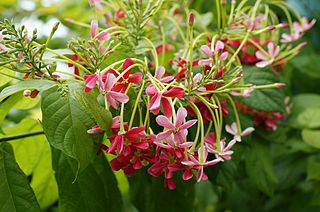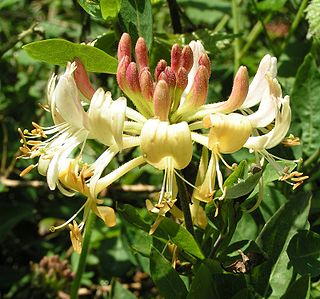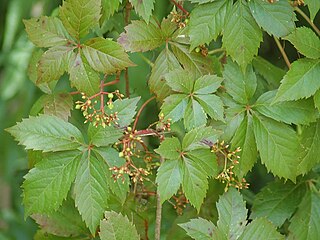
A vine is any plant with a growth habit of trailing or scandent stems, lianas or runners. The word vine can also refer to such stems or runners themselves, for instance, when used in wicker work.

Honeysuckles are arching shrubs or twining vines in the family Caprifoliaceae, native to the Northern Hemisphere. Approximately 180 species of honeysuckle have been identified. About 100 of these species can be found in China and approximately 20 native species have been identified in Europe, 20 in India, and 20 in North America. Widely known species include Lonicera periclymenum, Lonicera japonica and Lonicera sempervirens. In North America hummingbirds are attracted to the flowers on some of these plants, especially L. sempervirens and L. ciliosa. Honeysuckle derives its name from the edible sweet nectar obtainable from its tubular flowers. The name Lonicera stems from Adam Lonicer, a Renaissance botanist.

Lonicera morrowii, the Morrow's honeysuckle, is a deciduous honeysuckle in the family Caprifoliaceae, native to Japan, Korea, and Northeast China. It is a shrub, reaching a height of 2-2.5 m, with oblong leaves 4–6 cm long. It leafs out quite early in the spring, and in North America is commonly the first deciduous shrub with foliage in March. The flowers are white to pale yellow, and the fruit is a dark red berry 7–8 mm diameter containing numerous seeds. The berries, while eaten frequently by birds, are considered poisonous to humans. It is colloquially called "bush honeysuckle" in the United States, and is considered an invasive species.

Lonicera japonica, known as Japanese honeysuckle and golden-and-silver honeysuckle, is a species of honeysuckle native to eastern Asia including China, Japan, and Korea. It is a twining vine able to climb up to 10 m (33 ft) high or more in trees, with opposite, simple oval leaves 3–8 cm (1.2–3.1 in) long and 2–3 cm (0.79–1.18 in) broad. The flowers are double-tongued, opening white and fading to yellow, and sweetly vanilla scented. The fruit is a black spherical berry 3–4 mm (0.12–0.16 in) diameter containing a few seeds.

The common marbled carpet (Dysstroma truncata) is a moth of the family Geometridae. It is sometimes placed in the genus Chloroclysta. It is very common throughout the Palearctic region and the Near East.
Creeper, Creepers, or The Creeper may refer to:

Diervilla, or bush honeysuckle, is a genus of three species of deciduous shrubs in the family Caprifoliaceae, all indigenous to eastern North America. The genus is named after a French surgeon Dr. Marin Diereville, who introduced the plant to Europe around 1700.

Parthenocissus inserta, also known as thicket creeper, false Virginia creeper, woodbine, or grape woodbine, is a woody vine native to North America, in southeastern Canada and a large area of the United States, from Maine west to Montana and south to New Jersey and Missouri in the east, and Texas to Arizona in the west. It is present in California, but it may be an introduced species that far west.

Combretum indicum, also known as the Chinese honeysuckle or Rangoon creeper, is a vine with red flower clusters and is found in Asia. It is found in many other parts of the world either as a cultivated ornamental or run wild. Other names for the plant include Quiscual, Niyog-niyogan, Madhu Malti or Madhumalti, ମଧୁ ମାଳତି Madhumalati, Madhabilata, Malati, Madhumaloti, Akar Dani, Rangoon Malli and Radha Manoharam. It is not closely related to the true honeysuckle species Lonicera tragophylla which is also called the Chinese honeysuckle.

Eumorpha achemon, the Achemon sphinx, is a moth of the family Sphingidae. The species was first described by Dru Drury in 1773. It is native to North America, where it is known from most of the United States, southern Canada, and northern Mexico. It is rare or absent in the Pacific Northwest, Great Basin, and Southeastern United States except Florida.

Lonicera involucrata, the bearberry honeysuckle, bracted honeysuckle, twinberry honeysuckle, Californian Honeysuckle, twin-berry, or black twinberry, is a species of honeysuckle native to northern and western North America, from southern Alaska east across boreal Canada to Quebec, and south through the western United States to California, and to Chihuahua in northwestern Mexico. It grows at elevations from sea level to 2,900 m.

Lonicera canadensis is a flowering deciduous, perennial, phanerophytic shrub which is monoclinous and grows 1–2 m tall. It is the only member of its genus with hairless leaf structures. It typically flowers from the last week of April until the third or fourth week of May. Fruit appears approximately the first week of June until the first week of August. The fruit is feed upon by a variety of avian frugivores including the Robin and Cardinal.

Parthenocissus henryana is a species of flowering plant in the vine family Vitaceae, native to China. It is a vigorous, deciduous tendril climber growing to 10 m (33 ft). It has a more restrained growth than the other Virginia creepers. The large palmate leaves consist of five to nine oval leaflets, each up to 12 cm (5 in) long, with strong white veining. The leaves colour to brilliant red in autumn before falling. Clusters of inconspicuous flowers in summer may be followed by black fruits.

Pityopsis ruthii is a rare species of flowering plant in the aster family known by the common name Ruth's golden aster. It is endemic to the US state of Tennessee, where it is known only from Polk County. It is threatened by the modification of its habitat. It is a federally listed endangered species.

Diervilla lonicera, commonly referred to as northern bush honeysuckle, low bush honeysuckle, dwarf bush honeysuckle, or yellow-flowered upright honeysuckle, is a native deciduous shrub found in the northeastern United States and Canada. Its specific epithet, lonicera refers to its similarity in appearance to the true honeysuckles, genus Lonicera.

Frasera caroliniensis, commonly known as American columbo or yellow gentian, is a herbaceous perennial of the gentian family Gentianaceae found in the deciduous forest of Southern Ontario and throughout the eastern and southeastern United States. It was previously known as Swertia caroliniensis.



















